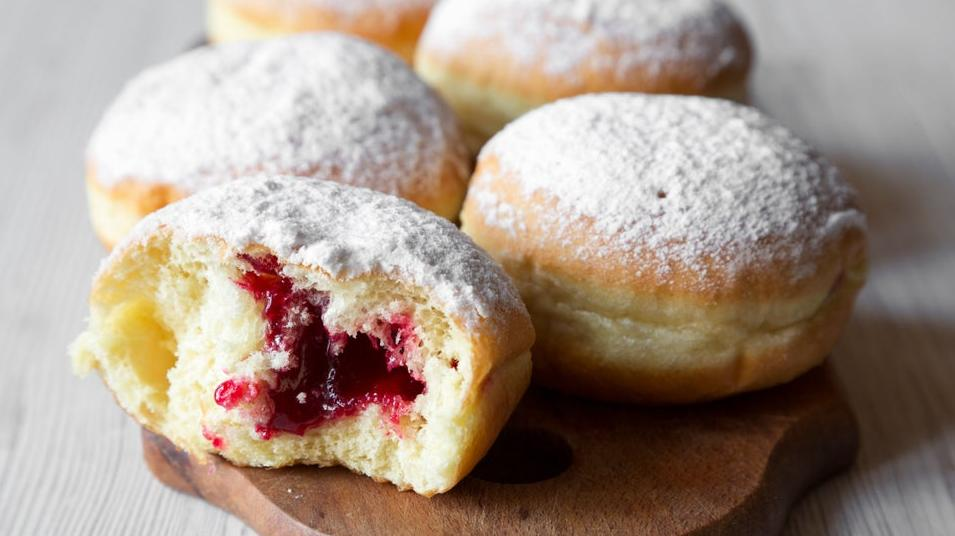Sufganiyot Are The Sweetest Part Of Hanukkah
The Hanukkah doughnut has a long history and can take many forms, all delicious.
Sunday was the first night of Hanukkah. And while the holiday is a relatively minor one in the Jewish calendar, it punches above its weight as a cultural event. Not only does it have a lean but effective canon of holiday music (Adam Sandler's "The Chanukah Song"; Haim's cover of "The Chanukah Song"), but its central foods are unimpeachable.
As Jews commemorate the miracle of a small pot of oil keeping the menorah in the Second Temple lit for eight days, foods fried in oil are elevated. Latkes are probably the best iteration of a fried potato, and their co-conspirators applesauce and sour cream provide two diverging but equally tasty avenues. And sufganiyot, or jelly doughnuts, are the ringer of the whole meal.
"Hanukkah" is the Hebrew word for "dedication." And just as the Jews had to rededicate their temple after fighting to reclaim it, so too are we commanded to dedicate ourselves to deep-fried, jelly-filled doughnuts this time of year.
A brief history of sufganiyot
The Hanukkah story took place around 200 BCE when Jewish rebels successfully regained control of their temple from a Hellenistic state, the Seleucids. And a long span of time passed before the first mention of anything resembling a doughnut.
In the 12th century, Rabbi Maimon ben Joseph, father of famed Jewish philosopher Maimonides, commented on the importance of Hanukkah tradition.
"One should not be lenient regarding any custom, even the lightest of customs," he wrote. "And one is obligated to make every effort to prepare festivities and actions to publicize the miracle that God did for us on those days. It has become customary to make "sufganin" [sufganiyot]... This is an ancient custom, because they are fried in oil, in remembrance of His blessing."
Back in the middle ages, Maimonides and his dad certainly did not eat a jelly doughnut akin to one you might find at your local convenience store. The name itself is a mashing of Greek and Hebrew influences and refers to a spongy dough. Here's how Israeli newspaper Haaretz explains it:
"In 1897, the teacher David Yalin translated the 'The Vicar of Wakefield, a novel by Irish writer Oliver Goldsmith, into Hebrew. He got stumped when he came to the word shortbread (to this day Hebrew doesn't have a word for shortbread). So he made up a word – sufganiyot — based on the sufganin of old."
Sufganiyot is a good example of the diverse food traditions found within the global Jewish community. For Sephardic Jews (those hailing from the Iberian Peninsula), the doughnut du jour would most likely be a bunuelo. Jews across the Middle East and North Africa might eat what's known as a Sfenj in Morocco or zalabiyeh in Yemen. These pastries are usually topped with something sweet like honey or powdered sugar. So while in America we might associate jelly filling with sufganiyot, different fried pastries are enjoyed elsewhere, and have been for centuries.
As for why jelly is in our sufganiyot, that's where Europe comes into play. As the transatlantic slave trade was established between Africa, Europe, and North America, the passage brought more sugar to Europe, as well as new fruit. An early take on a German jelly-filled Berliner, fried in lard, was printed in a 15th-century cookbook. As the Atlanta Jewish Times writes, "Jews substituted kosher chicken or goose fat [for lard] and served their own version on Chanukah." So really, the only thing that separates a Bismark donut or a Polish paczki from sufganiyot is the cooking method. Polish Jews even gave their kosher paczki its own name, ponchik. If kosher, it counts as sufganiyot.
From the late 19th century through the Holocaust, Jews fled Eastern Europe for what was then Ottoman Palestine or, later, British Palestine. They brought the tradition of the jam-filled doughnut with them.
In 1920, sufganiyot took off in a big way in Mandatory Palestine. Then-rising Jewish labor organization the Histadrut Labor Federation saw an opportunity in the much more time- and skill-intensive jelly doughnut.
"By pushing the sufganiyot as a symbol of the Festival of Lights, as opposed to the DIY-friendly latke, the Histradut could encourage the creation of more jobs for Jewish workers," TIME magazine explains.
Sufganiyot remain beloved and relevant today
Today, sufganiyot is even starting to appear on drink menus. In San Francisco, Italian restaurant Fiorella is rolling out some Hanukkah-inspired drinks. One is a Sufganiyot cocktail, which "riffs on a white Russian cocktail, combining vodka, strawberry, creme de cacao, and cream with a cinnamon-sugar-salt rim."
And in New York City, Hanukkah-themed popup bar Maccabee Bar has its own play on a doughnut-forward cocktail. "We have the Hebrew Hammer," founder Naomi Levy explained to the Jewish Telegraphic Agency, "which is inspired by sufganiyot. We make a leavened sugar, which is basically a yeasted simple syrup, to give you that kind of yeasty sensation of a doughnut, but it's actually a really nice dry, sour cocktail."
Both drinks are temporary seasonal offerings, but they sound fun and inventive—both start with the same inspiration, yet result in two very different cocktails. It's just one more example of the great variety within Jewish cuisine around the country and around the world. That's something to raise a doughnut to and celebrate.
